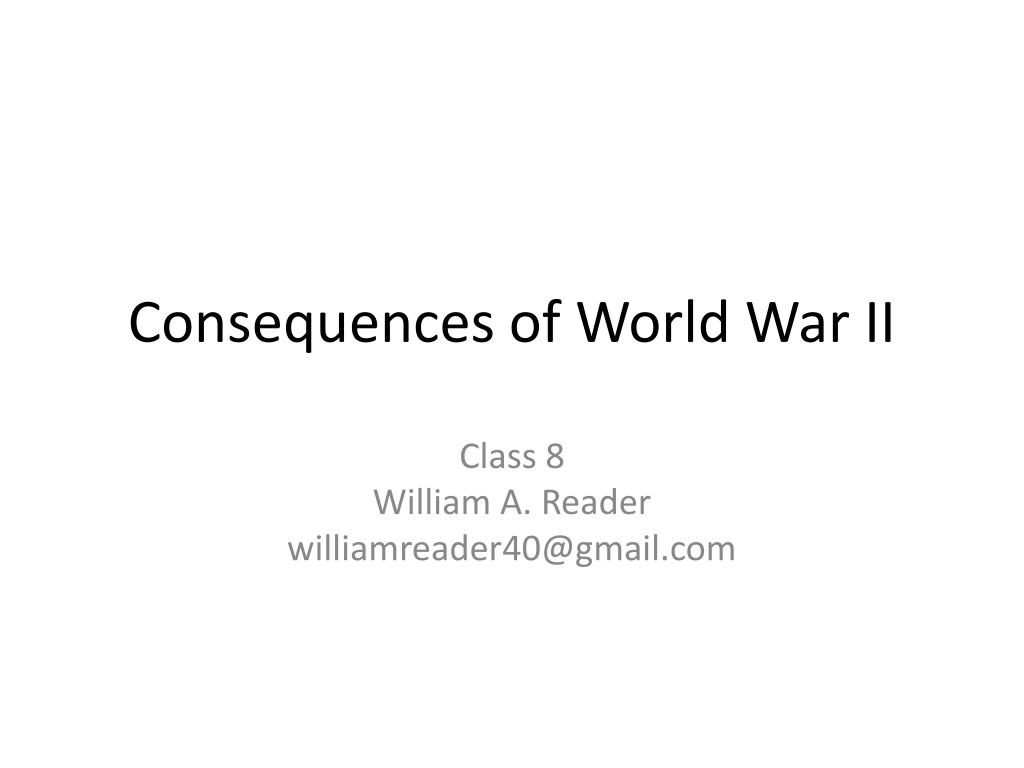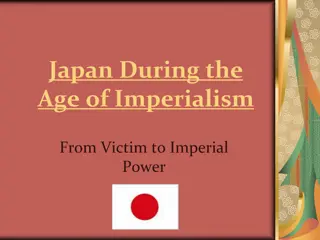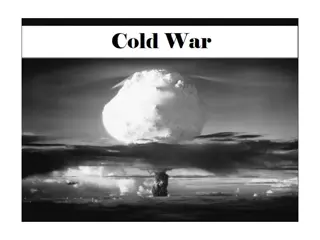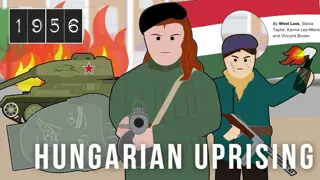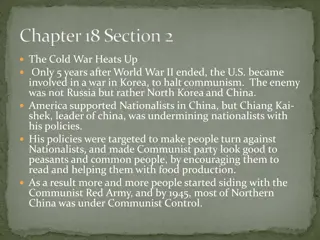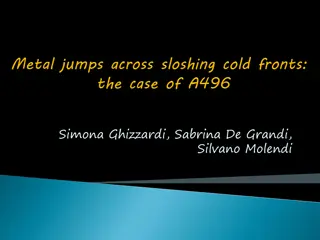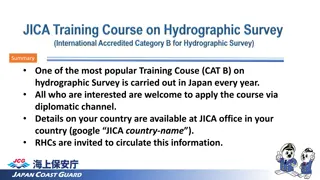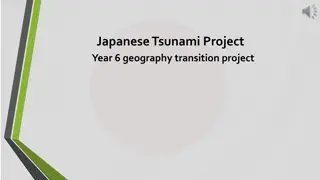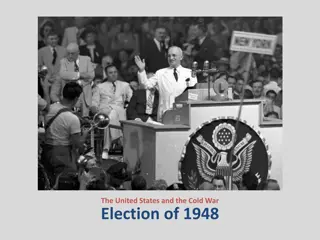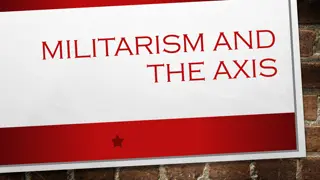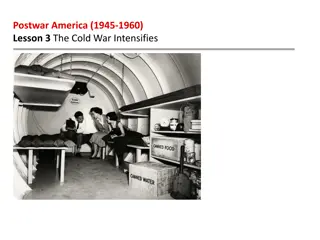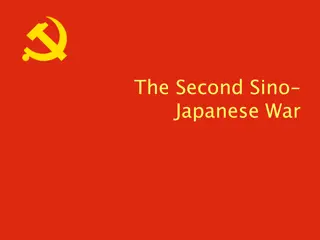The Impact of World War II on Japan and the Emergence of the Cold War
World War II had far-reaching consequences on Japan, leading to significant naval battles, intense fighting in Okinawa, and ultimately, the country's surrender following the atomic bombings of Hiroshima and Nagasaki. The post-war period saw the emergence of the Cold War as tensions rose between the Soviet Union and the Western allies.
Download Presentation

Please find below an Image/Link to download the presentation.
The content on the website is provided AS IS for your information and personal use only. It may not be sold, licensed, or shared on other websites without obtaining consent from the author. Download presentation by click this link. If you encounter any issues during the download, it is possible that the publisher has removed the file from their server.
E N D
Presentation Transcript
Consequences of World War II Class 8 William A. Reader williamreader40@gmail.com
Invading the Philippines Having decided to invade Luzon rather than Formosa, the next step was Leyte The conquest of Leyte would provide land-based air support for the invasion of Mindoro and then Luzon From Luzon, amphibious landings could be made in the Bonin Islands (Iwo Jima) and the Ryuku Islands (Okinawa) The Japanese saw retention of the Philippines as vital to protect their lines of communication with Southeast Asia This was to precipitate the largest set of naval battles in history in which the remainder of the Japanese Navy was sunk
Raising the flag on Mt Suribachi on Iwo Jima Of the six men in the picture, only three survived the battle.
Okinawa Okinawa had large airfields, an excellent harbor, and was within easy range of the Japanese home islands The Japanese had over 100,000 men to defend the island They established their defense lines in the mountainous southern portion of the island where they expected to hold the Americans while kamikaze attacks on their ship-borne supply system was expected to drive off the American Navy, leaving the Americans without supplies and vulnerable to a Japanese counterattack Fighting on Okinawa lasted from 1 April to 22 June 1945 There were 75,000 American casualties The Japanese launched 2,000 kamikaze attack sorties
Japanese Surrender Despite having its cities destroyed by incendiaries and its islands blockaded by American ships, Japanese leaders were determined to continue the war Two factors led to the surrender The atomic bombing of Hiroshima and Nagasaki The entry of the Soviet Union into the war Only then did Japan decide to surrender, provided the imperial system remain, and even then it almost did not happen
The Emerging Cold War Political scientists note that all nations seek security They also note that things a nation does to enhance its own security can often seem threatening to other nations This is the situation that arose after World War II Neither the Soviet Union nor the Western Allies wanted a recreation of the unstable international situation that led to World War II Both groupings wanted a stable world in which they could achieve their international objectives The problem was that the Western Allies and the Soviet Union had radically different view as to what a post-war world should look like
Diverging Goals Stalin s goals To ensure that no external threat would ever again place his country at risk To rebuild the war-torn Soviet Union The first goal meant attempting to dominate the European continent as thoroughly as Hitler attempted to do This meant the creating of pro-Russian regimes in Eastern Europe and Germany Roosevelt s goals To establish democratic regimes in Eastern Europe and eventually in Germany To establish a new global economic system which would prevent the recurrence of the Great Depression To deter and, if necessary, punish aggression by the creation of a new collective security organization
Poland The only way to reconcile Stalin s and Roosevelt s requirements would be if all of the Eastern European countries had been willing to elect leaders who were willing to follow a pro-Russian policy This Czechoslovakia and Finland did, but Poland could not follow this path since Stalin s prior actions had eliminated any possibility that a Polish government subservient to the Soviet Union could sustain popular support The Nazi-Soviet Pact The murder of some 4,000 Polish officers at Katyn Forest in 1940 Doing nothing when the Nazis brutally suppressed the 1944 Warsaw uprising even though the Red Army was on the outskirts of Warsaw at the time Soviet taking of a third of Poland s territory after the war
Poland - 2 Since Poland would never elect a pro-Soviet government, Stalin decided to impose one This resulted in a permanently resentful Poland Stalin s imposition of a Soviet-style government on Poland in violation of his promises at Yalta convinced the Americans and British that Stalin could not be trusted As a disillusioned Roosevelt put it, Stalin has broken every one of the promises he made at Yalta
Occupied Germany It had been decided at Yalta that Germany would be divided into separate occupation zones, with Berlin (even though it was in the Soviet zone) similarly divided The Soviet zone contained a third of Germany s population, but few of its industrial facilities Stalin believed that the Soviet zone with its Marxist-Leninist government would act as a magnet for Germans in the western zones This, Stalin believed, would cause the West Germans to elect leaders who would eventually unify the country under Soviet control
Occupied Germany - 2 There were two big problems with Stalin s plan The brutality of the Red Army in occupied East Germany Mass expropriation of property and extraction of reparations on an indiscriminate scale The rape of 2 million German women The way the Soviets had handled their affairs in Eastern Europe and in their zone of Germany made the British and the Americans wary of cooperation with Moscow Thus the Western Allies refused Russian demands for reparations from their zones This led the Western Allies to follow a policy of preserving their zones of Germany under Western rule rather than risk the danger that all of Germany fall under Soviet control
The Far East The events in Eastern Europe and Germany in turn convinced the United States to exclude the Soviet Union from any role in the occupation of Japan The Soviet decision to declare war on Japan and invade Manchuria and North Korea had two major impacts It resulted in the partition of Korea It persuaded the Japanese to surrender The Atom bombing of Hiroshima and Nagasaki intensified Stalin s insecurity and led him to institute a crash Soviet A-bomb program to catch up with the United States
The Full Emergence of the Cold War The Communist coup d etat in Czechoslovakia and the blockade of Berlin persuaded the Western European recipients of Marshall Plan aid that they needed military protection as well This led the Europeans to request the creation of the North Atlantic Treaty Organization (NATO) This committed the United States for the first time ever to the defense of Western Europe It also led to the creation of the Federal Republic of Germany [West Germany] This in turn led to the creation of the Democratic Republic of Germany [East Germany]
Little Boy the Uranium Bomb dropped on Hiroshima
To Drop or Not to Drop Before the Trinity test at Alamagordo, many doubted that a plutonium bomb would work The decision to use the bomb against Japan was neither easily reached nor unanimous ADM William Leahy, Secretary of War Henry Stimson, GEN Dwight Eisenhower, and Leo Szilard opposed using the bomb Secretary of State James Byrnes, Vannevar Bush, MGEN Leslie Groves, GEN George C. Marshall, and Robert Oppenheimer favored use of the bomb The proponents of using the bomb won out Truman s attitude was that the bomb would save American lives that would otherwise be lost in an invasion. There was no point in wasting American lives if a way existed to save them
Hiroshima At 8:16 AM on 6 August, the uranium bomb detonated 1,900 feet over the city of Hiroshima, turning the city to ashes The American scientists who created the bomb underestimated both the blast effect and the radiation produced by the bomb Among the soldiers and sailors who were expecting to assault Japan, the bomb was met with wonder and jubilation It was only later, after the publication of John Hersey s Hiroshima in 1946, that people began to question the decision to drop the bomb
Consequences - 1 One of the consequences of Hiroshima was a long scholarly (and sometimes political) controversy over whether it was right to use the bomb Many have argued that Japan was near surrender and that a blockade and conventional bombing would have eventually forced either a Japanese surrender or an overthrow of the regime Others have argued that the Japanese militarists were determined to fight to the end and that the shock of the bomb was necessary to induce surrender As Stimson and Szilard feared, Hiroshima prompted Stalin to give top priority to Russia s nuclear bomb program. This gave rise to the nuclear arms race and the fear of nuclear war
Consequences - 2 The fact that Russia got the bomb in 1949 came as a great shock to the American people The fact of Soviet espionage at Los Alamos and the belief that Russia was too backward to produce a bomb on its own led to the belief that Russian spies stole the atom bomb, thus giving rise to anti-communist hysteria and MacCarthyism The fact of the atom bomb raised the question of delivery of the bomb to its target This led to the race to build long-range bombers, intercontinental ballistic missiles, and nuclear submarine- launched missiles
Consequences - 3 Although there were times when Russia and the United States came close to war, the Bomb played a major role in preventing the outbreak of war between the two powers Mutually Assured Destruction (MAD) did have a deterrent effect, leading the two powers to be cautious in their dealings with each other Reinforced and modified the current of apocalyptic/millenarian thought in American culture Before the Atomic Age, end-of-the-world or apocalyptic beliefs were limited to fundamentalist religious groups who believed that the end of the world required some form of divine intervention With the Atomic Age, a secular apocalypticism arose, based on the likelihood of nuclear war
Consequences - 4 Since nuclear chain reactions could occur slowly in a reactor as well as explosively in a bomb, nuclear scientists realized that nuclear energy could be used to generate electricity Unlike conventional power plants which consumed vast quantities of coal, oil, or natural gas, nuclear plants would consume very little uranium or plutonium and theoretically could generate electricity cheaper than conventional power plants Nuclear power enthusiasts claimed that the electricity generated would be too cheap to meter In addition, nuclear power did not cause air pollution As a result, nuclear power came to generate about 19% of America s electricity
Germany & Eastern Europe Before the War Before World War II, East-Central Europe generally lacked clearly shaped ethnic settlement areas. Rather, outside of some ethnic majority areas, there were vast mixed areas and abundant smaller pockets settled by various ethnicities. Often different ethnic groups shared the same area but belonged to different socio-economic classes Rural landowners and industrialists were often disproportionately German Urban professionals and entrepreneurs ns were often disproportionately Jewish or German Despite its economic backwardness, Eastern Europe had a vibrant Yiddish culture Germany was a world leader in culture, science, and technology
Europe After the War An ethnically heterogeneous Eastern Europe had become a set of ethnically homogeneous nation-states ruled by Communists A vibrant Yiddish-speaking culture had been totally destroyed Much of Germany s and Eastern Europe s intellectual capital had been either destroyed or frightened into fleeing or was expelled Germany was no longer a world leader in culture, science, and technology Eastern Europe had become a cultural backwater The United States, Great Britain, Palestine, and the British Dominions of Canada, Australia, and South Africa, saw an influx of displaced persons and refugees from Eastern Europe
Reasons for this Change The flight of a large number of the German Jews from pre- war Nazi Germany Part of this was the large-scale intellectual migration of European intellectuals, artists, writers, and scientists to the United States The mass extermination of the European Jews Also, the large scale murder of the Roma and many of the educated elite of Eastern Europe The bringing of forced labor from elsewhere in Europe to the Reich Not all of them wanted to return home after the war The large number of civilian and military war casualties The flight and later the expulsion of the Germans from Eastern Europe The migration of Jewish Holocaust survivors out of Europe (mostly to Palestine and America)
Intellectual Migration Field Names Science Albert Einstein, Enrico Fermi, Edward Teller, Leo Szilard, Hans Bethe, Victor Weisskopf Erik Erikson, Hannah Arendt, Leo Strauss, Erich Fromm, Max Horkheimer, Paul Lazarsfeld, Theodore K Adorno Claude Levi-Strauss, Bronislaw Malinowski Karen Horney, Bruno Bettelheim, Anna Freud Jacques Maritain, Rudolf Carnap, Herbert Marcuse Thomas Mann, Erich Maria Remarque, Vladimir Nabokov, Bertold Brecht Political & Social Science Anthropologists Psychologists Philosophers Novelists & Playwrights Composers & Musicians Igor Stravinski, Bela Bartok, Arnold Schoenberg, Paul Hindemith, Darius Milhaud, Kurt Weill, Arturo Toscanini, Bruno Walter, Otto Klemperer, George Szell, Erich Leinsdorf, Dimitri Mitropoulos, Rudolf Serkin, Gregor Piatigorski Walter Gropius, Ludwig Mies van der Rohe Marc Chagall, Wassily Kandinski, Piet Mondrian, Marcel Duchamp, Max Ernst, George Grosz, Andre Breton, Jacques Lipschitz, Salvador Dali, Joao Miro Architects Painters & Sculptors
A Note about the Holocaust The Holocaust took one form in the Soviet Union and another in the rest of Europe In the Soviet Union (largely between June and November 1941), special task forces killed one million Soviet Jews, usually by mass shooting This created problems as far as the SS was concerned First, it was inefficient rounding up and shooting people individually or in small groups was time consuming Second, the killers were having problems dealing with the guilt feelings and psychological stress involved in the killing of helpless men, women, and children Too often, they were getting drunk, abusing family members when on leave, and freaking out In the rest of Europe, the killing began (except on an experimental basis) in 1942 and went through the stages noted in the following slide
The Holocaust outside the Soviet Union The Holocaust Process outside the Soviet Union went through the following stages: 1. Creation of Ghettos 2. Transport of People to the Ghettos 3. Slow starvation of the ghetto 4. Creation of the Death Camps 5. Transport of ghetto inhabitants to either the Death Camps or a Concentration Camp 6. Culling of the new arrivals 7. Death for most; concentration camp slavery for the rest
The Liberation of the Camps American journalists and soldiers were shocked and horrified by what they had seen in the camps The Allies ordered thousands of nearby residents to visit the camps and see the horrors up close The encounter with the concentration and death camps left the Allies with the conviction that World War II was the good war since it eliminated a regime that people could only regard as diabolically evil Unfortunately, many who survived the Nazis died soon afterward, sometimes unwittingly at the hands of the Western Allies
Jewish Survivors The Jews in the post-war displaced persons camps consisted of four separate categories of people Survivors of concentration and death camps About 200,000 of the millions of Jews who entered the camps Those who spent the war in hiding Those who spent the war in the Soviet Union Those who fought with the partisans Those who had Aryan papers What united all of them was a desire to get out of Europe and emigrate to either Palestine or America This reflected both a realization that there there was nothing to go back to their families and communities had been destroyed and the visit of the charismatic David ben-Gurion to the camps
The German Removal from Eastern Europe The removal of the Germans from Eastern Europe went through three somewhat overlapping phases 1. The spontaneous flight and evacuation of Germans in the face of the advancing Red Army from mid-1944 to early- 1945 2. The disorganized expulsion of Germans immediately following the Wehrmacht s defeat 3. The organized expulsion following the Potsdam Agreement which both defined the new borders of Central Europe and approved the orderly expulsion of Germans from Poland, Czechoslovakia, and Hungary
The Process of Expulsion Toward the end of June 1945, word went round the villages and farms of Pomerania and Silesia that the Germans must get out It was common for Polish and Russian police and soldiers to come to a German house and give its residents a half hour to pack and leave, with only the items they could carry or push in a handcart Since the refugees were old men, women, and children, they were often robbed of their valuables by Polish and Russian soldiers and the women sometimes raped
A Humanitarian Disaster The refugees had to feed themselves so that many suffered from hunger and thirst; many also suffered from exposure in winter and the heat in summer The result of the expulsions was a humanitarian disaster An estimated 600,000 to 2,200,000 Germans died during the refugee flights from the advancing Soviet Army and the post-war expulsions from Poland, Czechoslovakia, Hungary, and elsewhere in eastern Europe Roughly 12 million Germans were expelled from Eastern Europe 7 million from the Eastern provinces of Germany that were annexed by the Soviet Union and Poland East Prussia, Pomerania, Danzig, and Silesia 3 million from Czechoslovakia 2 million total from Hungary, Romania, and Yugoslavia
Other Population Movements The roughly 12 million German expellees were only the largest part of a number of population transfers, expulsions, and movements In 1940, there was a population transfer of Germans living in the Baltic states (which had just been annexed by the Soviet Union) to German-occupied Poland In 1941-42, ethnic Germans living in Russia were deported to Siberia and Kazakhstan In 1945, over a million Poles living in parts of Poland annexed by the Soviet Union were resettled in areas annexed from Germany About 7,800,000 Eastern Europeans were brought to the Reich to labor for the Germans Within those brought to the Reich, a large number of Poles, Lithuanians, Latvians, Estonians, Byelorussians, and Ukrainians in Germany had no desire to return to their homelands
Consequences Turned an ethnically heterogeneous Eastern Europe into a set of ethnically homogeneous nation-states Fearful of the emergence of a united Germany, Supportive of a divided Germany, Ruled by native Communists seen as subservient to Russia Still possessed by a lingering anti-Semitism although there were virtually no Jews Changed the demographic composition of both East and West Germany In East Germany, expellees constituted 24.2% of the total population In West Germany, they constituted 18% of the total population Led many displaced persons and concentration camp survivors to emigrate out of Europe Precluded West German acceptance of Potsdam and the new frontiers with Poland until 1991 and then only as part of a package that included German reunification and the evacuation of Russian troops from East Germany
Why the GI Bill There were several factors that contributed to the creation of the GI Bill The fear that there would be a depression after World War II just as there had been after World War I Hence a desire to provide a buffer against unemployment by having veterans postpone their entry into the job market by going to either college or trade school The housing shortage in urban areas which would become potentially explosive when millions of GIs returned home The realization that the rise of Fascism and Nazism had been aided by the discontent of demobilized servicemen after World War I whose needs had been neglected The lobbying efforts of the American Legion and other veterans organizations
Key Provisions Enabled veterans to receive $20 a week for 52 weeks while they were looking for work Provided up to $500 a year for tuition and other educational expenses plus $50 a month subsistence for each month in uniform Provided no down payment mortgages that were federally guaranteed Provided small business loans for veterans seeking to establish a business
What the GI Bill Accomplished Colleges were transformed from a bastion of elite youth into a middle-class entitlement Large numbers of veterans from working-class backgrounds became college-educated members of the middle class A nation of renters became a nation of suburban homeowners Suburbs mushroomed and inner cities lost their members of the middle class
College Roughly 8.8 million veterans took advantage of the GI Bill s education benefits 2.2 million attended colleges or universities 6.6 million attended some kind of educational institution (trade school, high school, vocational school, or seminary) By 1947, half of all college students were veterans Academically, veterans got better grades than non- veteran college students Led to an expansion of college enrollments and the idea that people seeking to join the middle class should go to college
College - 2 The Bill s education benefits made possible the education of 14 Nobel Prize winners 2 Presidents (Gerald Ford & George H.W. Bush) 3 Supreme Court Justices 12 Senators 24 Pulitzer Prize winners 238,000 Teachers 91,000 Scientists 67,000 Doctors 450,000 Engineers 240,000 Accountants 17,000 Journalists
Famous GI Bill Grads Authors Gore Vidal, Norman Mailer, Frank McCourt, Art Buchwald, Mario Puzo Stage & Screenwriters Paddy Chayevsky, Rod Serling, Terry Southern, Aaron Spelling Actors Walter Matthau, Robert Duvall, Tony Curtis, Gene Hackman, Clint Eastwood, Paul Newman, Jason Robards, Charles Bronson, Harry Belafonte, Rod Steiger Artists Robert Rauschenberg, Leo Krikorian, Leroy Neiman Poets James Dickey, Lawrence Ferlinghetti
Education The GI Bill gave rise to an entire vocational industry Before the war, there were 100 private vocational schools in the country By 1950, there were 10,000 vocational schools, providing training in everything from flying a plane to cooking a gourmet meal The Culinary Institute of America, founded in 1946, became the top chef training program in the country
Home Ownership - 1 The GI Bill helped touch off a home building boom In 1940, less than 1/3rdof American families owned their own home (and most of these were farm families) By 1949, 60% of American families were homeowners Before the war, only 1 out every 6 Americans lived in the suburbs Housing construction was a craft industry with no two suburban houses looking alike Within a couple of decades, a majority of Americans lived in the suburbs Suburban housing had taken on a cookie-cutter look
Home Ownership - 2 During the war, William Leavitt, a SEABEE who built military housing, saw the advantages of assembly-line construction using prefabricated building elements Levitt had the idea of using these mass production techniques to build a whole neighborhood of cookie- cutter homes that could be sold cheaply to the returning veterans and their families Levitt sold his basic home for $7,990 on 25-year mortgages After the first Levittown (in suburban Long Island), Levittown-like instant suburban communities began springing up all over the nation
